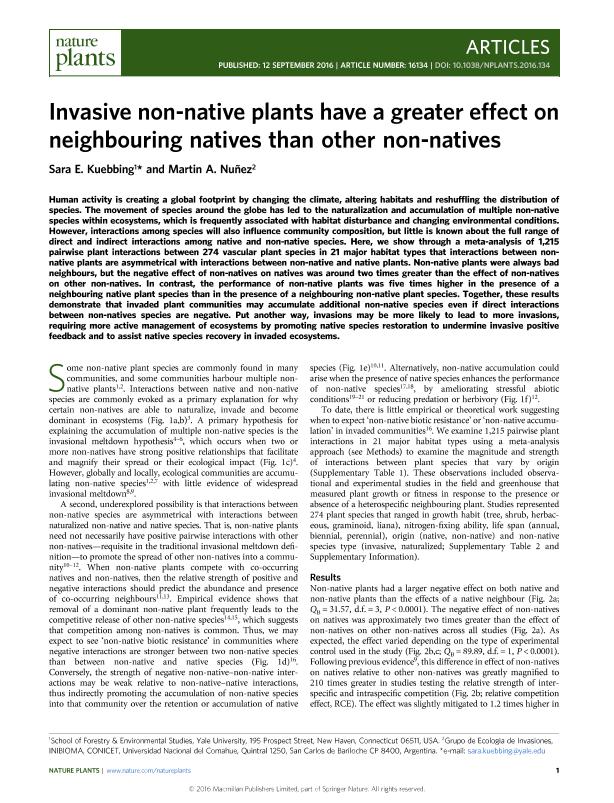Mostrar el registro sencillo del ítem
dc.contributor.author
Kuebbing, Sara E.
dc.contributor.author
Nuñez, Martin Andres

dc.date.available
2019-01-30T15:43:29Z
dc.date.issued
2016-09-12
dc.identifier.citation
Kuebbing, Sara E.; Nuñez, Martin Andres; Invasive non-native plants have a greater effect on neighbouring natives than other non-natives; Palgrave Macmillan Ltd; Nature Plants; 2; 10; 12-9-2016; 1-7
dc.identifier.issn
2055-0278
dc.identifier.uri
http://hdl.handle.net/11336/68981
dc.description.abstract
Human activity is creating a global footprint by changing the climate, altering habitats and reshuffling the distribution of species. The movement of species around the globe has led to the naturalization and accumulation of multiple non-native species within ecosystems, which is frequently associated with habitat disturbance and changing environmental conditions. However, interactions among species will also influence community composition, but little is known about the full range of direct and indirect interactions among native and non-native species. Here, we show through a meta-analysis of 1,215 pairwise plant interactions between 274 vascular plant species in 21 major habitat types that interactions between non-native plants are asymmetrical with interactions between non-native and native plants. Non-native plants were always bad neighbours, but the negative effect of non-natives on natives was around two times greater than the effect of non-natives on other non-natives. In contrast, the performance of non-native plants was five times higher in the presence of a neighbouring native plant species than in the presence of a neighbouring non-native plant species. Together, these results demonstrate that invaded plant communities may accumulate additional non-native species even if direct interactions between non-natives species are negative. Put another way, invasions may be more likely to lead to more invasions, requiring more active management of ecosystems by promoting native species restoration to undermine invasive positive feedback and to assist native species recovery in invaded ecosystems.
dc.format
application/pdf
dc.language.iso
eng
dc.publisher
Palgrave Macmillan Ltd

dc.rights
info:eu-repo/semantics/openAccess
dc.rights.uri
https://creativecommons.org/licenses/by-nc-sa/2.5/ar/
dc.subject
Non-Native Plants
dc.subject
Neighbouring Natives Plants
dc.subject.classification
Otras Ciencias Biológicas

dc.subject.classification
Ciencias Biológicas

dc.subject.classification
CIENCIAS NATURALES Y EXACTAS

dc.title
Invasive non-native plants have a greater effect on neighbouring natives than other non-natives
dc.type
info:eu-repo/semantics/article
dc.type
info:ar-repo/semantics/artículo
dc.type
info:eu-repo/semantics/publishedVersion
dc.date.updated
2019-01-23T18:57:11Z
dc.journal.volume
2
dc.journal.number
10
dc.journal.pagination
1-7
dc.journal.pais
Reino Unido

dc.journal.ciudad
Londres
dc.description.fil
Fil: Kuebbing, Sara E.. University of Yale. Yale School of Forestry & Environmental Studies; Estados Unidos
dc.description.fil
Fil: Nuñez, Martin Andres. Consejo Nacional de Investigaciones Científicas y Técnicas. Centro Científico Tecnológico Conicet - Patagonia Norte. Instituto de Investigaciones en Biodiversidad y Medioambiente. Universidad Nacional del Comahue. Centro Regional Universidad Bariloche. Instituto de Investigaciones en Biodiversidad y Medioambiente; Argentina
dc.journal.title
Nature Plants
dc.relation.alternativeid
info:eu-repo/semantics/altIdentifier/doi/http://dx.doi.org/10.1038/NPLANTS.2016.134
dc.relation.alternativeid
info:eu-repo/semantics/altIdentifier/url/https://www.nature.com/articles/nplants2016134
Archivos asociados
